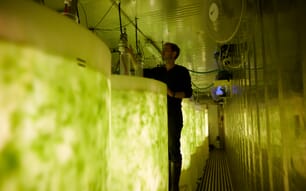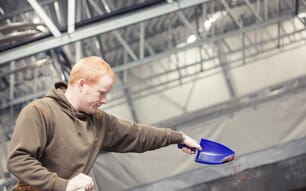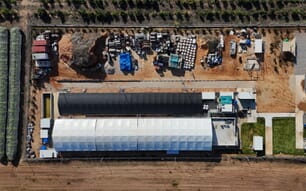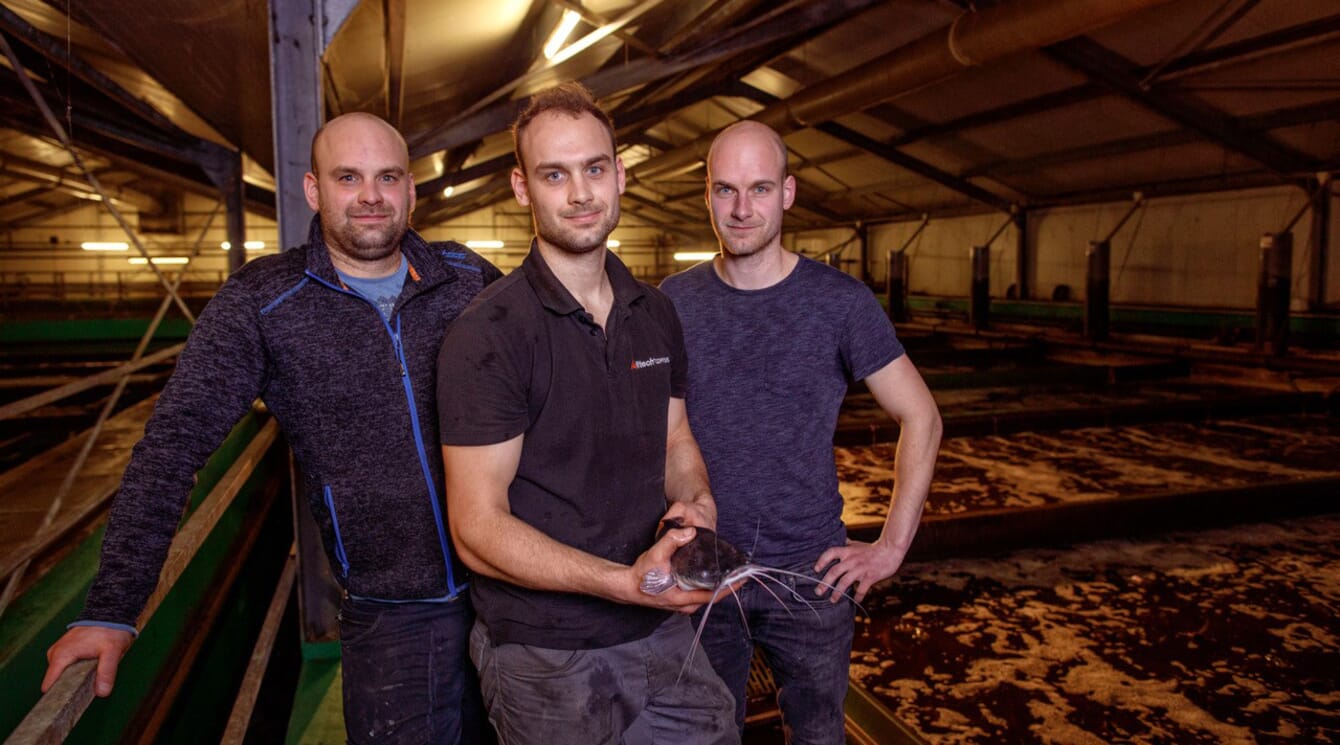
The brothers' parents – who started fish farming in 1996 – initially farmed eel but switched to catfish because they wanted to farm a fish that didn’t rely on stocking with wild-caught juveniles
What drew you to the aquaculture sector?
We are a real family company. My parents were pig farmers and started fish farming in 1996, so we grew up on a farm and helped a lot in the company when we were little. The company grew bigger and slowly one by one we decided to start in our family business. I liked the unknown, entrepreneurship and working with family. We had to figure out a lot for ourselves, which can cost a lot of energy but is beautiful when it works.
Why did you decide to grow catfish?
We initially started with eel back in 1996, but after many years we found out that it was hard, expensive and not sustainable for the future. My parents wanted to farm a fish for the future that didn’t rely on seasonal stocking with wild-caught juveniles. With the catfish hybrid, Claresse – which is a cross between Heterobranchus longifilis and Clarias gariepinus – that we are farming now we can control everything, from egg to fillet, in one location.
Can you give an overview of your farm?
At the moment our farm has a capacity of 50 tonnes of whole fish per week, but this could be increased. Our hatchery has a bigger capacity than we need for our own operations, so we can also supply other farmers with juveniles when needed.
What does a typical day in your job involve?
My brother Geert mainly takes care of the farm, my other brother, Mark, takes care of maintenance and ensures that everything keeps running, as well as taking care of new projects, such as buildings, machinery and filters. I mainly take care of processing, staff and clients.
I start by discussing the orders for that day. During the morning I have contact with our clients about new orders which have to be transported that afternoon. I keep an eye on quality and make sure everything will be sent on time. Besides the daily operations I also plan ahead for the following year in terms of volumes and prices.
We don’t need to rely on seasons and can produce fish the whole year round. We can make fixed numbers with fixed prices and continuous quality. This advantage also means we have to make strong agreements with our clients.
Having your own company, especially one that involves live fish, means you have to work seven days a week.
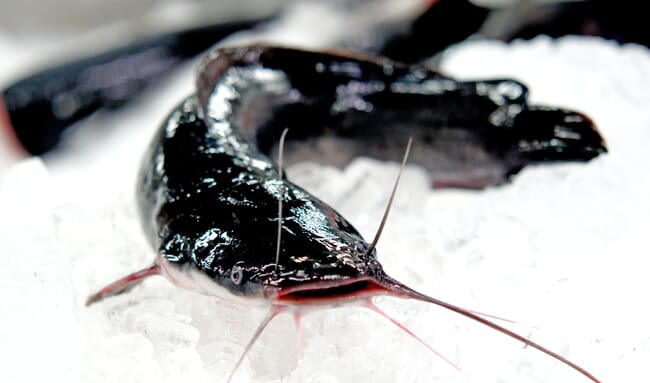
The catfish hybrid, Claresse, is a cross between Heterobranchus longifilis and Clarias gariepinus
What have been the main milestones in the development of the farm?
The moment you think that you have seen it all, there will be always something to surprise you. When we started we had to discover a lot for ourselves, which cost a lot of time, money and sleepless nights. So I have a lot of respect for my parents in that matter.
In 2012 we started filleting ourselves and a few years later we moved our hatchery to the same location. From that moment on we had everything in one location and this resulted in better control and quality. It also saved a lot of time and money regarding transport, energy, water and made the operation even more sustainable. We have also improved on quality, leading to better results at all stages of the process.
What challenges still remain?
Changes and adjustments will never stop – if we run into a problem we fix it ourselves or improve it. In recent years we have invested a lot in improving sustainability – with the use of heat pumps, solar panels and improved waste management. We have over 1,800 solar panels and some heat pumps that draw energy from waste water, our cold store and from the waste air. We have also replaced the water pumps with more energy efficient ones. And we are always looking for solutions to make things less labour-intensive. But all of this must not affect the quality of the fish.
Straight after processing we calculate our yields and feed conversion ratios (FCRs). These results are available in real time but also historically, which allows us to see which parents produce the best fish. We can also select those fish with better yields – for example those with smaller heads or less fat. This helps to keep us ahead of other farmers.

Currently the farm has a capacity of 50 tonnes of whole fish per week, but Foolen is confident this number can increase
Who are your key customers, and how is demand for catfish changing?
Most of our customers are fish traders, because they can buy in bigger volumes. They ship our fish all around the world but mostly to Germany, Poland and Hungary.
We would like to sell more in The Netherlands, of course, but to get in the supermarket here you need to be ASC certified. Even though we follow best practices, there is no ASC standard for catfish. We have been busy with ASC for over 12 years to get a standard but it has been very hard. ASC has now promised that the standard will be ready in 2026, which will open new markets for us.
The demand is growing slowly. We like clients who we can grow with and we are getting more and more reliable clients who are taking fish regularly, as we can deliver high quality fish continuously at steady prices, which builds good, long-term relationships.
We can produce a steady amount of fish every week, which is important. Any fillets that we don’t sell fresh that day, we freeze and store in our own cold store. This way we don’t flood the market but only produce on demand.
I think this should be the way of all food production: see what the demand is and not just produce as much as you can for the lowest prices. We are here to stay and not to make short-term profits.
Why do you think so many RAS operators have struggled to become profitable?
We have visited a lot of fish farms all over the EU and beyond. To build a good RAS farm is very expensive. A big problem we have seen is that there is not enough knowledge. We have seen brand new farms which have cost many millions but were never going to work because they are badly designed. We have also seen those who have gone for cheaper options, but they should consider performance many years ahead to see what would be best.
To see a farm which is badly designed is also bad for us, so we help a lot of other farms with our knowledge. If they are selling catfish of bad quality in terms of off-flavour or appearance, it is also bad for our business, as consumers will think catfish in general is bad and won’t buy it again. It is very hard to win these consumers back.
We have put a lot of money and energy into developing a good working RAS. Here in the Netherlands we have very strict environmental regulations to follow, which increase our costs but also mean we have to be more innovative. We have a state-of-the-art filtering system, really good water quality and a very low water use.
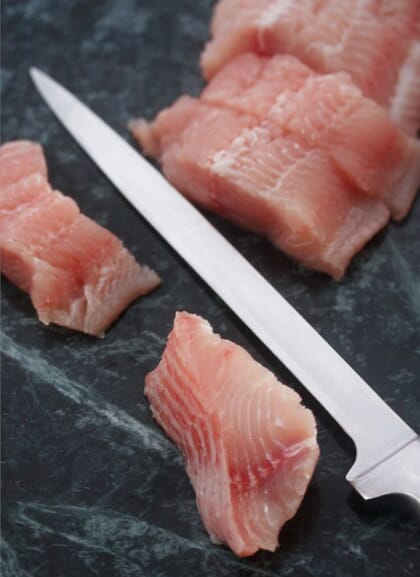
With all the company's facilities based in one location in The Netherlands, the fish have travelled less than 1 km from egg until filleting
What makes your farm different from the majority in terms of economic viability?
We are the second generation now and hopefully our children will take over, which means we make long-term investments, sometimes with the next generation in mind. That’s different from a company with stakeholders who want to see money as soon as possible.
We also have short lines and although we are directors we also have our boots in the mud and can jump in anywhere if needed – from filleting, to cleaning, to farming. This also results in good knowledge and we can think of both sides when we have to make difficult decisions.
For example, when Covid-19 started sales collapsed and we immediately decided to farm less fish. It took half a year before the decision made an impact on harvest volumes, but if we had continued to stock the normal amounts then we would have had to freeze a lot of fish and could have gone bankrupt.
We must also quickly decide if a client needs big numbers of fresh fish for the same week or day. As part of a promotion this is a decision we can make quickly because we have everything in one location.
Despite this it is hard to maintain good profits because of the costs of feed and energy, things we can’t control. We want to give our clients long-term price agreements but we can’t always do the same with our suppliers.
However, by building a solid relationship to our clients, it’s easier to explain why prices change.
How do your catfish compare with those grown conventionally in other parts of the world?
Claresse produce good quality meat, and because it is a hybrid and doesn’t grow reproductive organs, all its energy goes into growth. So we can produce 1 kg of fish with only 800 grams of feed.
We operate a closed system with our own water source from 300 m below the ground. The only thing that comes from outside is our feed, which is specially made for us. This means we can farm without any medicines or antibiotics.
Our filter system removes all solids, most which can be used as fertilisers on nearby farms, and 95 percent of the filtered water goes back into the system. The remaining 5 percent goes in to the municipal water purification plant, and the government does checks on the volume of water and whether it contains any pollution, which we have to pay for. We even drain the heat from the wastewater with a heat pump.
Because it is all on one location the fish have travelled less than 1 km from egg until filleting. Ninety five percent of our customers are in Europe, which means there are fewer food miles than for many imported fish.
What advice would you give to anyone looking to establish – or invest in – a RAS facility?
You have to question yourself why you want to start farming fish. And first undertake good market research.
Everyone can learn fish farming, but you have to understand that it’s a big investment to build a farm and a long time before any cashflow is generated. It will only work with a good system and the right knowledge in place, otherwise it would be better to burn the money in the casino.
How do you see the farm developing in the coming years?
We see a good future in fish farming, but we know it’s not easy to be successful. For 20 years we’ve been told that farming fish is going to be the next big thing, but it is still hard. We are a relatively small family company – there are not big investors behind us and we have to be careful with every euro we earn and invest. But we are committed to making it a success while also helping others. We have been doing it for over 25 years and we are ready to continue for another 25.

